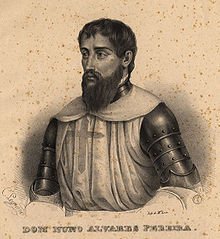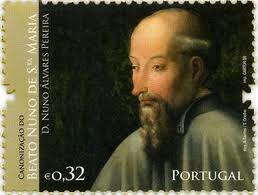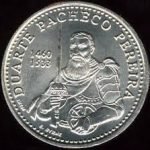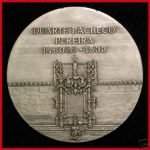
The Portuguese Pereira Dynasty
1280 AD – Dom Gonçalo (Gonçalves) Pereira, 97th Archbishop of Braga is born. He was to become a Portuguese clergyman, politician and audacious warrior. Raised at the palaces of King Denis of Portugal and student at the University of Salamanca, he returned to Portugal and was nominated Dean of the see of Porto and charged with negotiations with the Curia Romana.
1322 AD – Dom Gonçalo Pereira is elected 27th Bishop of Lisbon on August 21. He is elevated to Archbishop of Braga in 1326. He mediated the disagreements between Denis and his son Afonso IV of Portugal, being an auxiliar of Queen Elizabeth of Aragon on her peacemaking mission.
1338 AD – As the Ambassador of Afonso IV of Portugal to Castile to obtain the peace between the two Kingdoms, he fought at the famous Battle of Salado. He died on 22 December, 1348. Gonçalo Pereira and Teresa Peres Vilarinho are the parents of Álvaro Gonçalves Pereira and the paternal grandfather of the Saint Constable of Portugal Nuno Álvares Pereira.
Nuno Álvares Pereira
 1360 AD – Nuno Álvares Pereira is born the 24th of June in Flor da Rosa, near Crato, central Portugal, the illegitimate son of Dom Álvaro Gonçalves Pereira, (Prior of Crato) and Iria Gonçalves do Carvalhal. His grandfather was Dom Gonçalo (Gonçalves) Pereira, 97th Archbishop of Braga (1326–1349). He descended from the oldest Portuguese and Galician nobility. About a year after his birth, the child was legitimized by royal decree and so was able to receive a knightly education typical of the offspring of the noble families of the time. At thirteen years of age he became page to Queen Leonor. At age 16, he married Leonor de Alvim, a rich young widow, daughter of João Pires de Alvim and wife Branca Pires Coelho and childless widow of Vasco Gonçalves Barroso. Three children were born to the union, two boys who died early in life, and a girl, Beatrice, who would eventually marry Afonso, first Duke of Bragança, son of King João I.
1360 AD – Nuno Álvares Pereira is born the 24th of June in Flor da Rosa, near Crato, central Portugal, the illegitimate son of Dom Álvaro Gonçalves Pereira, (Prior of Crato) and Iria Gonçalves do Carvalhal. His grandfather was Dom Gonçalo (Gonçalves) Pereira, 97th Archbishop of Braga (1326–1349). He descended from the oldest Portuguese and Galician nobility. About a year after his birth, the child was legitimized by royal decree and so was able to receive a knightly education typical of the offspring of the noble families of the time. At thirteen years of age he became page to Queen Leonor. At age 16, he married Leonor de Alvim, a rich young widow, daughter of João Pires de Alvim and wife Branca Pires Coelho and childless widow of Vasco Gonçalves Barroso. Three children were born to the union, two boys who died early in life, and a girl, Beatrice, who would eventually marry Afonso, first Duke of Bragança, son of King João I.
1373 AD – Nuno begins military service at age 13, and helped stop an invasion from Castile invasion. However, according to his own words, his first military campaigns were no more than skirmishes on the borders of Portugal. He was an impetuous and brave young man who soon showed himself to be an excellent leader.
1383 AD – King Fernando I of Portugal dies, his only heir was Beatrice, married to King John I of Castile. In order to preserve Portuguese independence, the nobles supported the claim of King Fernando’s step-brother John, Master of Aviz to the throne. John was a natural son of Peter I of Portugal.
1384 AD – After his first victory over the Castilians, in the Battle of Atoleiros (April), João of Aviz named Nuno Álvares Pereira Protector and 2nd Constable of Portugal in practice supreme commander of Portugal’s armies and 3rd Count of Ourém. He was only 23 years old. Nuno used guerilla tactics trying to dislodge the Castilian army besieging Lisbon in 1384 but plague finally drove them away.
1385 AD – João of Aviz was recognized as king by the kingdom assembly (the Cortes) as John I. This triggered an invasion of the country by Juan I of Castile, in support of his wife’s rights to the throne. Nuno Álvares Pereira was engaged against the northern cities loyal to the Castilians. During this time of war, he fed the hungry populations of his Castilian opposition at his own expense.
The Battle of Aljubarrota

On 14 August 1385, at Aljubarrota Nuno Álvares Pereira led 6,500 volunteers to victory against a Castilian force of 30,000, thus ending the threat of annexation was over. He attributed the victory to the Blessed Virgin, whose name, Maria, was inscribed on his sword Dedicated to Mary, he fasted on Wednesdays, Fridays and Saturdays. The banner he chose as his personal standard bore the image of the cross, of Mary and of the saintly knights James and George. At his own expense he built numerous churches and monasteries, among which was the Carmelite church in Lisbon and the church of Our Lady of Victories at Batalha.
After the 1383-1385 Crisis, Álvares Pereira received from King John I the titles of 2nd Count of Arraiolos and 7th Count of Barcelos, which along with the previous one were the only three Countdoms existing at the time and which had been taken from Noblemen who took part for Castile. He was also made the 38th Mordomo-Mór (Major Majordomo) of the Realm.
Not wanting to give the enemy room to maneuver, John I and his supreme general took the offensive and raided several Castilian towns, defeating once again a much larger Castilian army at the Battle of Val Verde. He continued to watch out for Juan I of Castile, until his death in 1390. When hostilities ended, he gave the bulk of his wealth to the veterans.
1423 AD – After the death of his wife, he joined the Order of Carmelite at the Carmo Convent (Lisbon) which he had founded in fulfilment of a vow, and took the name of Friar Nuno of Saint Mary (in Portuguese: Irmão Nuno de Santa Maria). There he lived until his death on Easter Sunday of 1431. He was noted for his prayer, his practise of penance and his filial devotion to the Mother of God. Nuno suffered from debilitating arthritis.
During the last year of his life, King John I went to visit and embrace him for the last time. He wept, for he considered Nuno Álvares Pereira his closest friend, the one who had put him on the throne and saved his country’s independence.
Nuno Álvares Pereira’s tomb was lost in the famous 1755 Lisbon earthquake. His epitaph read:
“Here lies that famous Nuno, the Constable, founder of the House of Bragança, excellent general, blessed monk, who during his life on earth so ardently desired the Kingdom of Heaven that after his death, he merited the eternal company of the Saints. His worldly honors were countless, but he turned his back on them. He was a great Prince, but he made himself a humble monk. He founded, built and endowed this church in which his body rests.”
Nuno Álvares Pereira was beatified on January 23, 1918, by Pope Benedict XV.
 He had been on the point of being canonized by decree in 1940 by Pope Pius XII. According to a recent statement by the Postulator General of the Carmelite Order, his canonisation was postponed for diplomatic reasons (the Portuguese ambassador indicated that the time was not right),
He had been on the point of being canonized by decree in 1940 by Pope Pius XII. According to a recent statement by the Postulator General of the Carmelite Order, his canonisation was postponed for diplomatic reasons (the Portuguese ambassador indicated that the time was not right),
On July 3, 2008, Pope Benedict XVI signed two decrees in Rome, promulgating the heroic virtues of Nuno and the authenticity of a miracle that had already been previously confirmed as such by medical and theological Commissions. By this act, the Pope formally canonised Saint Friar Nuno de Santa Maria Álvares Pereira. The public celebration of his canonisation took place on April 26, 2009 in Saint Peter’s Square in the Vatican City.
Saint Nuno’s Feast Day is celebrated on April 1 except in Portugal where it is celebrated on November 6. A petition has been submitted to change the date universally to November 6.
Nuno Álvares Pereira sired only one daughter by his marriage to Leonor de Alvim, Beatriz Pereira de Alvim, who was to become the wife of Afonso, Count of Barcelos (natural son of John I of Portugal) and first Duke of Braganza. Therefore, Nuno Álvares Pereira was, through the female line, the ancestor of the House of Braganza which became the Portuguese Royal House in the 17th century, ruling the Kingdom of Portugal (1640–1910), the Kingdom of Brazil (1815–1822) and the Empire of Brazil (1822–1889)
 Duarte Pacheco Pereira (c. 1460 – 1533), called the Great, was a Portuguese sea captain, soldier, explorer and cartographer. He traveled particularly in the central Atlantic Ocean west of the Cape Verde islands, along the coast of West Africa and to India. His accomplishments in strategic warfare, exploration, mathematics and astronomy were of an exceptional level. Pacheco Pereira was the son of João Pacheco and Isabel Pereira.
Duarte Pacheco Pereira (c. 1460 – 1533), called the Great, was a Portuguese sea captain, soldier, explorer and cartographer. He traveled particularly in the central Atlantic Ocean west of the Cape Verde islands, along the coast of West Africa and to India. His accomplishments in strategic warfare, exploration, mathematics and astronomy were of an exceptional level. Pacheco Pereira was the son of João Pacheco and Isabel Pereira.
1455 AD – In his youth, Pacheco served as the King of Portugal’s personal squire. Having graduated with honors, he was awarded a study fellowship from the monarch himself.
1456 AD – Cape Verde was discovered by Luigi da Cadamosto, a navigator in the service of Portugal. Four years later, Diogo Gomes, a Portuguese explorer, visited the uninhabited islands, and colonists from Portugal began to settle there in 1462. People from W Africa were soon brought in as slaves, and by the 16th century the islands had become a shipping center for the slave trade. Later a Portuguese penal colony was established, and some of the convicts remained after completing their terms. Slavery was abolished on the islands in 1876. Portuguese Guinea (now Guinea-Bissau) was administered as part of the Cape Verde Islands until 1879

 1488 AD – Pacheco Pereira explores the west coast of Africa. His expedition fell ill with fever and lost their ship. Pacheco is rescued from the island of Príncipe in the Gulf of Guinea by Bartolomeu Dias when Dias was returning from rounding the Cape of Good Hope for the first time. As Captain-major of São Tomé he was preceded by João Pereira
1488 AD – Pacheco Pereira explores the west coast of Africa. His expedition fell ill with fever and lost their ship. Pacheco is rescued from the island of Príncipe in the Gulf of Guinea by Bartolomeu Dias when Dias was returning from rounding the Cape of Good Hope for the first time. As Captain-major of São Tomé he was preceded by João Pereira
Between the 16th and 18th Centuries, there is little record of the Pereira Dynastic movements. Given their devout religious distraction, ties to the Catholic faith and the rise of the protestant reformation against the excesses of Rome, it is highly likely that the reign of Terror by the Spanish Inquisition and Papacy required the acceptance of a low profile in the historic record.
